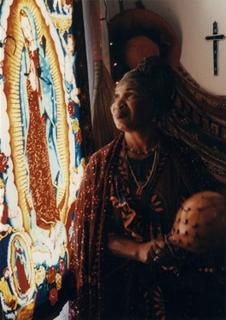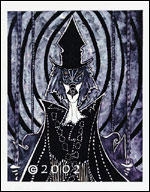Voodoo Mambo

On Patrick’s first visit to New Orleans, we wandered over to Rampart Street to visit the Voodoo Spiritual Temple. I was surprised because it reminded me more of one of those storefront churches that I remembered from my childhood. This place was totally different than the voodoo shops through the French Quarter that were basically built to cater to the tourist trade. There were hand packaged herbs, hand made gris-gris bags, cowry shells made into necklaces, and amulets of various descriptions. An impressive black woman dressed in a hand sewn extremely colorful dress and head cover walked out of the back room to greet us. It was Priestess Miriam. We all chatted a bit, and Patrick and I bought some magical potions and left.
Outside, Patrick turned to me and said I now know the Black Mother Miriam and the White Mother Myriam. Little did we know that my knowledge of the temple would grow over time through some interesting coincidences and that my respect and knowledge of fusion religions would forever be changed.
A week later, I met a French spitfire that was a friend of my son. Claudine was a tour guide in the French Quarter and did a voodoo tour in the afternoons and an evening ghost tour. She offered to let me go on her tours free which I gladly accepted.
She met the tourists, me included, at a small bakery and we began to walk through the voodoo history of New Orleans.
As we walked Claudine never stopped talking but with her accent and rapid-speed delivery I didn’t understand half of what she said. Her hands moved as fast as her lips as she pulled us through the Quarter pointing out places of interest from the classic tourist traps of the area but then she started walking toward to the edge of the Quarter and paused in front of a house that had been the home of Marie La Veau. She then began to spin the story of this famous scion of New Orleans’ voodoo.
Marie La Veau was a free woman of color who worked as a hairdresser to the wealthy and often offering them advice, potions and spells to handle the problems of love, health and business. Apparently someone had tried to take away Marie’s home and she cast a spell that caused him to get into dire circumstances. The final resolution that to have her remove the spell, he had Marie’s home returned to her.
As we continued our walk we arrived at Congo Square, now called Louis Armstrong Park which is located across from the Voodoo Spiritual Temple and Priestess Miriam.
It seems that Marie was definitely more than a hairdresser and helper of the wealthy elite. In New Orleans, slaves were given Sunday afternoon’s off because – well because it was a way to allow the slaves to worship. Voodoo to those not in the know or perhaps those in the know preferred to think that the slaves were just Christians but beneath faces of Saints lay the spirit of the loas and teachings of the African religion that the slaves brought with them to America.
On Sunday afternoon till six in the evening the slaves would gather on Congo Square where Mare La Veau was their Priestess. They would drink rum, smoke cigars and seem to be apparently just having a little steam release from the pressures of life. What was going on was the rituals of the old religion. The beating drums would intensify as the day wore on and Marie would be seen in the center of a circle dancing and expressing her passion for her spirits. There were often sacrifices of live animals, usually chickens and the blood and rum would flow and the drums would beat out the passion of divinity. As Marie would intensify her dance, she would be ridden by a loa with messages for the people. To be ridden by a loa is to have one’s body taken over and to become a channel.
As we left Congo Square we walked to the cemetery. Before we entered, we heard the story of St. Bridget and the Baron – the bride and groom of the cemetery. These are the loa that can exist in the underworld or the black side of magic and in the upper world which is the white side of magic. Upon entering the cemetery for protection, one would place coins at the entrance as gifts to the loa for protection. As we walked around we stopped at the tomb of Marie La Veau where one would see flowers and gifts placed as at an altar. There were red crosses marked on the tomb which were thanks for petitions that had been granted through the intercession of Priestess Marie.
As we walked through the cemetery, Claudine told the story about how widows would come at night with lamps and walk around the cemetery to listen for bells. At a time where people were sometimes buried because they appeared to be dead, but actually might be in a coma bells were tied on the fingers of the corpses and widows would come and walk and listen for the bells. People in the tour stopped and then heard tinkling bells. I looked down and remembered that I had on some bells that I carried as talismans that came from Malta and were considered protection from St. Christopher. We all sighed in relief and proceeded to the end of the tour which was the Voodoo Spiritual Temple on Rampart right across from the place where Marie La Veau conducted the rituals of her people.
We entered the storefront where I had first visited with Patrick but there was more to see. Priestess Miriam invited us into the temple which was in an adjoining room. It was filled with colorful and interesting altars in the name of various loa where one could make an offering to the divinity that is Voodoo. The gifts were simple. Cigarettes, a cup of coffee, some cornmeal, a bottle of rum, were some of the examples we saw. Each loa had a Saint’s name and the saint would have similar energies as the loa whom they masked.
At the back of the temple was a simple area with a bench, a table and some chairs. It was here that Priestess Miriam would do readings for the faithful and the curious. I noticed a cage which housed a snake which I was informed was Congo which Priestess Miriam would dance when doing rituals for her congregation in the same manner as Priestess Marie La Veau had done some hundreds of years ago.
I don’t know how to explain this but I felt at home. I felt a kinship with Miriam that I seldom feel with another person. It was not but a few weeks later through the help of Claudine that I came to work with Priestess Miriam or as some know her Mambo Miriam.






